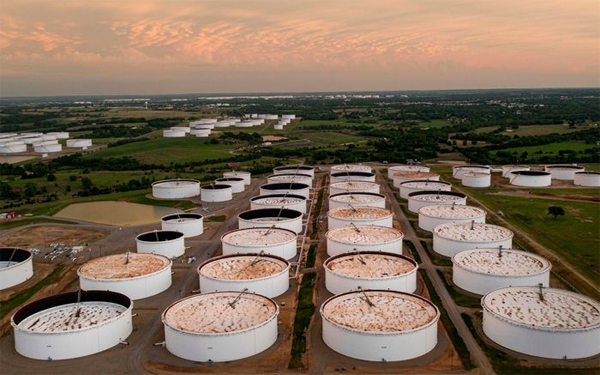
By Myra Saefong and Williams Watts/MarketWatch
SAN FRANCISCO/NEW YORK
EnergiesNety.com 03 22 2022
Oil futures finished higher Wednesday after the U.S. government reported a more than 6 million-barrel weekly decline in domestic gasoline supplies.
Prices for the commodity scored an added boost in roughly the last half hour of trading after the Federal Reserve’s latest decision on interest rates, which included what at least one analyst referred to as “softer” language on the outlook for rates.
Price action
- West Texas Intermediate crude for May delivery CL00, -1.31% CL.1, -1.31% CLK23, -1.31% rose $1.23, or 1.8%, to settle at $70.90 a barrel on the New York Mercantile Exchange. That was the highest finish for a front-month contract since March 14, according to Dow Jones Market Data.
- May Brent crude BRN00, -1.17% BRNK23, -1.17% climbed $1.37, or 1.8%, at $76.69 a barrel on ICE Futures Europe, also the highest settlement since March 14.
- Back on Nymex, April gasoline RBJ23, -0.80% tacked on 2.1% to $2.5932 a gallon.
- April heating oil HOJ23, -0.76% added 1.9% at $2.7403 a gallon.
- April natural-gas futures NGJ23, 2.07% fell 7.5% to $2.171 per million British thermal units after a 5.6% rise on Tuesday.
Fed decision
Oil prices climbed sharply into the close on Wednesday, with the Federal Reserve’s interest-rate decision announced about a half hour before futures prices settled for the session. The Fed raised its benchmark fed funds rate by a quarter of one percentage point to a range of 4.75%-5%.
Oil prices and equities rallied in the minutes following the Fed announcement, as the central bank’s “language around future rate hikes softened, which supports the outlook for risk assets,” said Troy Vincent, senior market analyst at DTN.
In a statement, the Fed said “some additional policy firming may be appropriate” to bring inflation back to the 2% target. That language replaced the previous statements that “ongoing increases” in the Fed’s benchmark rate would be needed.
The Fed “signaled that further rate hikes are likely, but at a slower pace than recent trajectory,” said Noah Barrett, research analyst at Janus Henderson Investors.
“For crude prices, the outlook for further hikes could be a negative as it implies that inflation is still a concern, and if we see higher rates leading to meaningfully lower growth, that would weigh on oil demand,” he told MarketWatch.
However, global supply and demand fundamentals “remain constructive and the combination of a supportive weekly [U.S. Energy Department] report and a view that future Fed hikes will be at a modest pace are helping support prices,” said Barrett.
Supply data
“Crude prices have been reeling over the past week amid fears of a credit crunch and banking contagion helping to precipitate a recession just as the lagged effects of tightening monetary policy were already set to take hold,” said DTN’s Vincent. “This led market participants to cut bullish speculative positions in recent weeks and a rise in hedging among producers.”
However, the Energy Information Administration’s weekly petroleum supply report revealed much larger than expected draws to gasoline and distillate fuel oil, “providing fundamental support to a market that has been beat down by financial risk considerations in recent weeks,” he said.
Domestic demand for fuels continues to remain weak, but net exports of fuels have “shot higher and this, coupled with U.S. crude export strength, continues to signal that the global oil market is relatively healthier than what is seen domestically,” said Vincent. “On a four-week average basis imports of both gasoline and distillate fuel oil are their weakest in over five years, while product exports are continuing to push higher.”
The EIA on Wednesday reported that crude inventories edged up by 1.1 million barrels for the week ended March 17.
On average, analysts forecast a decline of 5.5 million barrels, according to a survey by S&P Global Commodity Insights. The American Petroleum Institute late Tuesday reported a 3.3 million barrel rise in last week’s crude inventories, according to a source citing the data.
The EIA report also showed weekly inventory declines of 6.4 million barrels for gasoline and 3.3 million barrels for distillates. The analyst survey had forecast supply decreases of 2 million barrels for gasoline and 1.3 million barrels for distillates.
Crude stocks at the Cushing, Okla., Nymex delivery hub fell by 1.1 million barrels for the week, the EIA said.
marketwatch.com 03 22 2023












